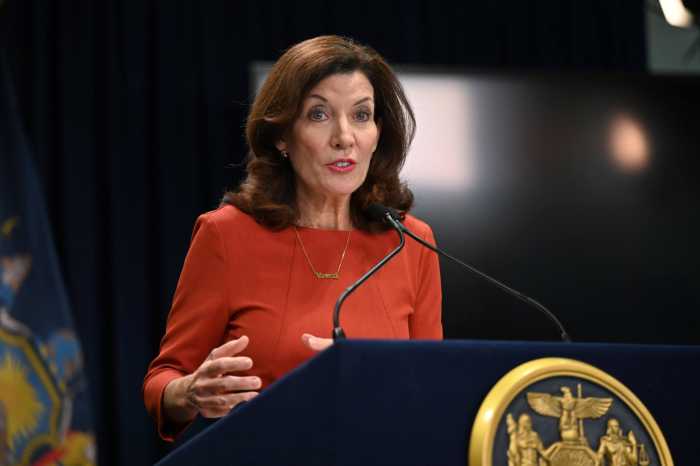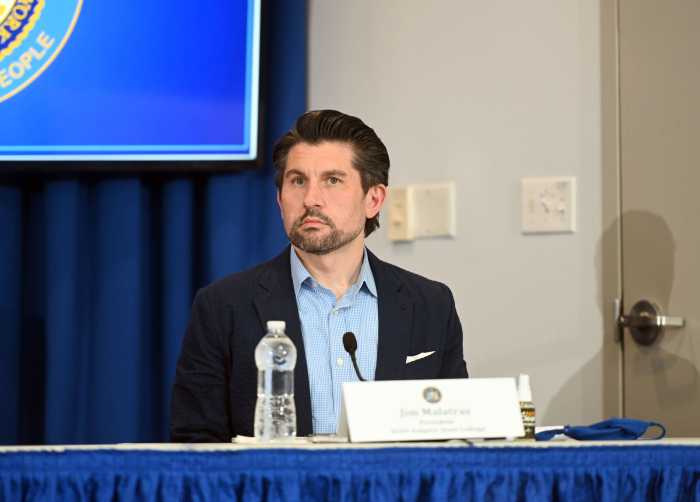Mayor Eric Adams on Friday released a new plan to improve safety on the subway, saying he intends to mobilize his entire administration to prevent violence underground and ensure those experiencing homelessness in the system get the help they need.
The plan, unveiled by Adams and Gov. Kathy Hochul at the Fulton Street subway hub, calls for increased NYPD deployment and “omnipresence” in the subterranean transit system, a requirement to enforce the MTA’s “code of conduct,” cross-agency teams tasked with outreach towards those experiencing homelessness and mental illness, and connecting them to services.
“The subway plan is a comprehensive civic strategy that will do more than deal with a temporary fix,” the mayor said. “You cannot put a band-aid on a cancerous sore.”
The new plan comes amid a rash of violent incidents in the subway attributed to those experiencing homelessness and untreated mental illness, most notably the death of Michelle Go after she was pushed onto the subway tracks at Times Square.
“Going forward, we will no longer give an option to exist in the system in this way,” Adams said. “The system is not made to be housing, it’s made to be transportation. And we have to return back to that basic philosophy, if someone is in physical or emotional distress, we can’t leave them on the train, for their own safety and the safety of others. That’s a betrayal. We must intervene and get help.”
Up to 30 of the interagency “Joint Response Teams,” collaborations between the Health Department, Homeless Services, NYPD, and community-based providers, will be deployed at transit hubs and at end-of-line subway stations with the aim of engaging homeless people in the system and connecting them to shelter, housing, and services. The mayor said that the aim of the new plan was to ensure people get the help they need and that offending behavior is corrected, rather than a show of force, but said that people would be forcibly ejected if they were found to pose a danger to themselves or others.
Meanwhile, officers will have to be more dogged in enforcing the MTA’s code of conduct, which prohibits smoking, using drugs, panhandling, carrying one’s belongings in a large shopping cart, and otherwise using the system as shelter rather than transportation.
The measures on the city level will be coupled with an increased investment in mental health services on the state level. The governor said that her budget proposal includes $27.5 million for more psychiatric beds, $12.5 million for 500 new supportive housing beds, and $9 million to recruit psychiatric health care personnel.
The plan also calls for new “drop-in centers” for those experiencing homelessness and an increse in “safe haven” and stabilization beds this year. The mayor also called on the state to expand “Kendra’s Law,” which empowers authorities to involuntarily commit people to outpatient treatment.
Homelessness in the subway has been on the rise in recent years but has come to the forefront in the wake of Go’s death, where a mentally ill homeless man who had encountered barriers to treatment pushed her onto the tracks, to her death.
Homeless advocate Shams DeBaron enthusiastically endorsed the plan while standing side-by-side with the mayor and governor on Friday, arguing that the plan seeks to help those dealing with homelessness rather than criminalize them.
“I’m so overwhelmed, it’s triggering in a good way,” DeBaron said. “I finally see that I’m dealing with an administration and a government that really cares for vulnerable New Yorkers and for all New Yorkers. And that’s what I’m about.”
But not every advocate shares his view. The Coalition for the Homeless said in a statement that the plan was cruel to those experiencing homelessness and would do little to end the homelessness epidemic, which affects tens of thousands of New Yorkers on a daily basis.
“Repeating the failed outreach-based policing strategies of the past will not end the suffering of homeless people bedding down on the subway,” said Shelly Nortz, deputy executive director for policy at the Coalition for the Homeless. “It is sickening to hear Mayor Adams liken unsheltered homeless people to a cancer. They are human beings. The Mayor’s own police department recently noted that those who shelter in the transit system are there because they believe they have no safer alternative. Criminalizi



































